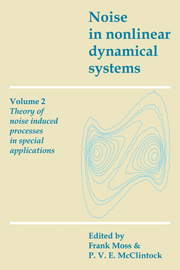Book contents
- Frontmatter
- Contents
- List of contributors
- Preface
- Introduction to Volume 2
- 1 Stochastic processes in quantum mechanical settings
- 2 Self-diffusion in non-Markovian condensed-matter systems
- 3 Escape from the underdamped potential well
- 4 Effect of noise on discrete dynamical systems with multiple attractors
- 5 Discrete dynamics perturbed by weak noise
- 6 Bifurcation behavior under modulated control parameters
- 7 Period doubling bifurcations: what good are they?
- 8 Noise-induced transitions
- 9 Mechanisms for noise-induced transitions in chemical systems
- 10 State selection dynamics in symmetry-breaking transitions
- 11 Noise in a ring-laser gyroscope
- 12 Control of noise by noise and applications to optical systems
- 13 Transition probabilities and spectral density of fluctuations of noise driven bistable systems
- Index
Introduction to Volume 2
Published online by Cambridge University Press: 05 January 2012
- Frontmatter
- Contents
- List of contributors
- Preface
- Introduction to Volume 2
- 1 Stochastic processes in quantum mechanical settings
- 2 Self-diffusion in non-Markovian condensed-matter systems
- 3 Escape from the underdamped potential well
- 4 Effect of noise on discrete dynamical systems with multiple attractors
- 5 Discrete dynamics perturbed by weak noise
- 6 Bifurcation behavior under modulated control parameters
- 7 Period doubling bifurcations: what good are they?
- 8 Noise-induced transitions
- 9 Mechanisms for noise-induced transitions in chemical systems
- 10 State selection dynamics in symmetry-breaking transitions
- 11 Noise in a ring-laser gyroscope
- 12 Control of noise by noise and applications to optical systems
- 13 Transition probabilities and spectral density of fluctuations of noise driven bistable systems
- Index
Summary
While in Volume 1 the treatments are confined exclusively to Fokker–Planck systems, a range of contemporary problems, indicative of the rich diversity of applications of noise driven dynamics, are reviewed in this volume. Though most problems currently treated are classical, recent work on dissipative quantum tunnelling has focused attention on quantum mechanical applications of stochastic dynamics. Chapter 1 builds on the theory of the Anderson–Kubo oscillator, generalized to account for colored noise effects, with applications to molecular spectroscopy. Helpful comparisons with the classical theory of Brownian motion are drawn. Chapter 2 reviews the important and highly topical problem of the crossover from classical Kramers-type thermal activation to the quantum tunnelling of particles out of a metastable state. Having set the stage with a discussion of classical Brownian motion in a periodic potential, the theory is applied to the diffusion of an impurity hopping among interstitial sites in a crystal lattice. An interesting non-Markovian application follows wherein the impurity is driven by a random force weighted around a characteristic frequency. Enhanced activation rates are observed when the noise correlation becomes comparable to the inverse characteristic frequency. This review concludes with a discussion of the formidable problem of quantum tunnelling in the low damping regime. Even classical treatments of this topic are fraught with difficulties, as the following review in Chapter 3 demonstrates. Building on Kramers' original treatment, the escape rate of particles from a metastable state is discussed in the limits of low and moderately high damping.
- Type
- Chapter
- Information
- Noise in Nonlinear Dynamical Systems , pp. xv - xviiiPublisher: Cambridge University PressPrint publication year: 1989

